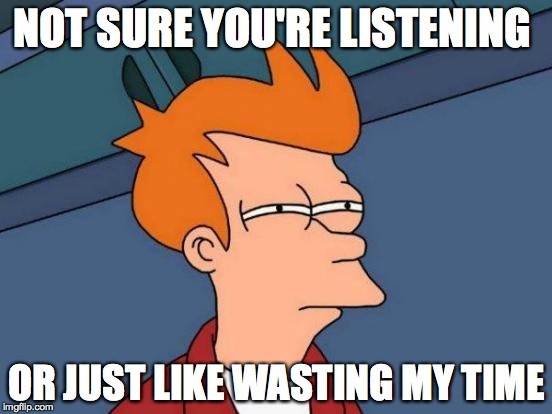Search Waypoint Resources
Stop Surveying Customers Like Lab Rats

Companies often treat their customers like lab rats.
A scientist “observes” behaviors and reactions of lab rats and records the information. They then process this data and make deductions based on this data.
Many companies adhere to the same technique to acquire information about their customer base. Which is great if your customer base is a bunch of rats. Scientists study lab animals to gather scientific data in order to draw conclusions and hypotheses. Not to improve the relationship between them and the rats, like your efforts should be doing.
When you send out a survey to “get a feel” for what’s going on in your customers’ minds,
you’re treating them like lab rats. Like a scientist, you are observing and purposely not interacting, which is why customers hate surveys. And this is why your survey winds up in the circular file or at the bottom of Tweety’s birdcage. The sad part is, Tweety is probably making better use of those surveys than you are.

So, you’ve sent out a survey, got 5% returned and then your research team overthinks the data to death and prepares some sort of analysis.
Now What?
Do you do anything?
You’d better, because you know those people who actually took the time out to fill it out and send it back? Well they’ll be sure to be disengaged if they gave you good feedback and you did nothing but “analyze” it.
Slowly they’ll begin to realize your surveys are a waste of time. They want to let you know they are unhappy about something and you refuse to listen.
So instead they let you (and a zillion other people) know their concerns by talking about it. Ahh yes…conferences, LinkedIn threads, blind references, and the plethora of B2B ratings sites that are springing up…these do to your company’s reputation what Volkswagen did to themselves by lying about car emissions.
The Black Hole
When customers think for one nanosecond that the information they provided you with is going into a black hole, 2 things happen:
- One, they realize any attempts to help you better serve them is fruitless. Which means there’s 0.0% chance of them filling out your next survey.
- Two, they decide to give “feedback” via other outlets. We know how that usually works out.
Make the interaction matter or don’t send it
Instead, engage your customers. Make it a back and forth. Having customers fill out a survey is not interacting. That’s like considering going to dinner with your 15 year old daughter while her face is buried in her phone the entire time as “interacting.” Social media is a great place to engage both exisiting and future clients in a meaningful fashion. If you have been neglecting your facebook and twitter profiles like so many business do, it’s high time you dusted them off and put to good work. For starters get following for your social media from a reliable provider like themarketingheaven.com so that you get more exposure. Then make a countious effort and come up with content that is funny, educational and related to your market. It’s not an easy task, but it pays off greatly!
I suggest not to do market research, or even customer research. Use feedback as a way to truly engage your customers. Find out which customers are “with you” and which are not, what they like and what they don’t, what contributes to their success and what doesn’t. When you have this information you can define an action plan for working with them. I’ve discussed this before here.
It gets worse

At least you can see negative feedback on social media. And if you have the gall and the savvy, you might even respond to it. Another way customers give feedback is by word of mouth. The real fun part about this type of feedback is that you don’t even know it’s happening.
Non-word-of-mouth is as bad as negative word of mouth. If someone asks a customer or ex-customer of yours for a recommendation in your field, and your name doesn’t come up, that’s a problem. Here was an opportunity to be recommended, which had a great chance of leading to a sales opportunity, and your company’s name never entered the conversation. That’s money left on the table. Trust me, no business ever became successful by making a habit of that sort of thing.
Avoid becoming a casualty
So how do you navigate the minefield of disasters that can be a byproduct of surveys? The same way you don’t get blown up on an actual minefield. You avoid it.
Instead of tossing a survey at your customers, engage them with a closed-loop feedback process. If you don’t have a relationship with your client, then use a feedback process to build it. Your front-line account teams need to be a part of the improvement process anyway, working through roadmaps, work-arounds, and best-practices. This is about improvement – helping your customers gain better results – and not research, right?
Your account teams should be soliciting feedback from the right people in their accounts – think decision makers, key leaders that influence decisions, project managers, and power users – and making sure they are following up to address customer needs. The rest of the company will need to support them because there’s only so much that they can do on the front-line before they either die from exhaustion or get blown out of the water by their customer for ineffective action. So read the feedback, assess the results, and put plans in place with your customers leveraging both one-to-one (account level) and one-to-many (product and service improvements that the front-line doesn’t control but must communicate and manage customer expectations) tactics. That’s good engagement and relationship-building, the cornerstone of B2B growth.
Treat your customers like rats and they’ll treat you like cheese. They’ll eat your reputation for breakfast.
Best practices for closing the loop:
6 Steps for Your NPS® Action Plan
[wpdm_package id=’15636′]